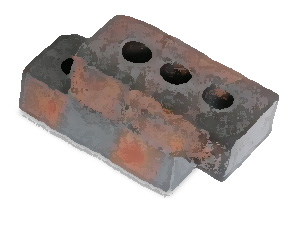|

The Brick Press
By Leah Browning
When I was in elementary school, my father bought a brick press. Our
small adobe house had begun to seem cramped since the birth of my baby
brother, and my parents had been eyeing the open stretch of dirt and
sagebrush between the back of the house and the piñon trees surrounding
it. For years, I had begged my parents to let me have my own bedroom,
and I was thrilled by the prospect of adding rooms to our house —
even if Dad did expect us to build the addition ourselves, literally
brick by brick.
He had already read a sequence of books about building and brickmaking,
gotten the necessary permits, and drawn up a set of elaborate plans,
which he laid out on the dining room table. He pointed to the paper,
where his neat printing earmarked two large bedrooms for my younger
sister and me. I knelt on a chair and examined the plans, envisioning
pale purple walls and an ornate canopy bed trimmed in white eyelet and
lace.
Unfortunately, as the weeks of planning continued, my dad's initial
design was downsized — reducing the two new bedrooms to one —
and my enthusiasm for the project dwindled proportionately. After all
the work was done, my sister and I would simply end up moving from one
bedroom to another, still together. As I saw it, our little brother,
who would get our old room all to himself, was the real beneficiary.
Nevertheless, my parents seemed determined to forge ahead with the construction.
I was familiar with the concept of an addition. In my mind, it had always
involved a series of sturdy boards and a can of nails, maybe a fun afternoon
spent painting new walls.
We lived in New Mexico , though, in an adobe house, and our particular
addition was painstakingly constructed using homemade adobe bricks.
The combination of materials, which included water, sand, and straw,
had to be perfect — too wet and the brick wouldn't hold its shape,
too dry and it would later crumble. Each batch of bricks, which required
back-breaking labor with the brick press, also required a long period
of sun-drying before the bricks were suitable for use.
Toward the beginning, there were moments when this process was exciting:
combining the ingredients for our first batch of bricks, using the brick
press for the first time, standing back to admire the first row of flawless
gray bricks laid out to dry. But the novelty quickly wore off.
As elementary school turned into middle school, I grew to hate the sight
of my "uniform," a set of old, ragged clothes and a pair of
heavy gloves. The project dragged on year after year with no end in
sight, and I complained bitterly about the unfairness of it all. None
of my friends had to spend their Saturdays pressing bricks in the backyard.
The addition wasn't completed until after I graduated from high school
and left home, so my sister and I never did move to the new bedroom.
Instead, we spent more time together than ever, standing behind the
house next to a brick press. She was a good sport, so she rarely complained
about the tedious hours of brickmaking, or the lack of personal space,
or my incessant griping about all of the above, though she was certainly
sympathetic. As long as we both lived at home, we continued to share
our same small room with its matching twin beds and bright rainbow bedspreads.
Now, though, this is one of the most enduring memories from my childhood.
The two of us alone together, without any purple walls or canopies.
Sometimes whining about sore muscles or the dream of separate rooms
gone awry, but more often just talking about life, long after bedtime,
lying there in the dark.
|
